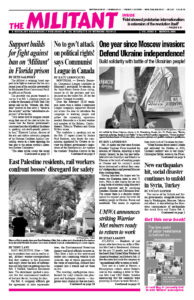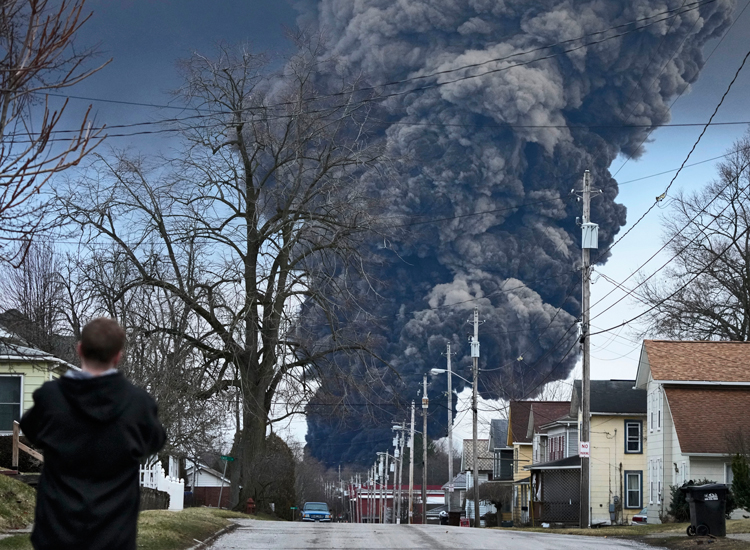EAST PALESTINE, Ohio — Talking to residents here and in nearby areas, Militant worker-correspondents find they continue to feel frustrated and angry about the lack of information and help they are getting since the Feb. 3 Norfolk Southern derailment here. The derailment sparked a massive fire that mushroomed hundreds of feet into the air, burning for days.
On Feb. 6, company officials got the agreement of state representatives, the Environmental Protection Agency and local officials to move in. They blew a hole in five overturned tanker cars containing volatile vinyl chloride, one of which appeared on the verge of exploding, drained their contents into a trench and set them on fire.
The resulting conflagration transformed the vinyl chloride into phosgene and hydrogen chloride — dangerous toxic chemicals that are heavier than air, falling onto the soil, homes and streams in the area.
Pennsylvania Gov. Joshua Shapiro sent a letter to Alan Shaw, CEO of Norfolk Southern, Feb. 14 questioning the burn-off. “Norfolk Southern failed to explore all potential courses of action, including some that may have kept the rail line closed longer but could have resulted in a safer overall approach for first responders, residents and the environment,” he wrote. “The company failed to notify state and local agencies responding to the incident about its decision to vent and burn all five cars containing vinyl chloride instead of one.”
Norfolk Southern bosses then shoved the damaged rail cars littering the area aside, rebuilt the tracks and began running trains again.

Norfolk Southern bosses and East Palestine officials agreed to organize a town hall meeting there Feb. 15 to answer questions from local residents. But, claiming they feared attacks by “outside agitators,” the company backed out of the meeting hours before it began. This just made people madder.
People there got angrier when Peter Buttigieg, secretary of transportation in the Joseph Biden administration, tried to minimize the danger of derailments. “While this horrible situation has gotten a particularly high amount of attention, there are roughly 1,000 cases a year of a train derailing,” he told Yahoo Finance.
At the same time, the derailment and its aftermath has intensified discussions among rail workers over the conditions they face, with bosses determined at all costs to boost their profits.
Rail labor, public are under attack
“As long as it is more profitable to clean up a disaster than to prevent one, these Wall Street-driven rail corporations will continue to hold communities like East Palestine hostage,” Jeremy Ferguson, president of the SMART-Transportation Division union, which organizes over 30,000 rail conductors and engineers, said in a Feb. 16 statement. Some of the country’s largest hedge funds, including BlackRock, J.P. Morgan Asset Management and The Vantage Group, are the central investors in Norfolk Southern and other Class 1 railroads.
Ferguson described the way rail bosses have implemented what they call Precision Scheduled Railroading in a drive to boost profits. “Due to PSR, trains are much longer than they used to be, with some now over 4 miles in length. Even as the trains have gotten longer, the workforce supporting them has gotten smaller,” he said.
This “has led us to the point where fewer railroaders with less training are taking longer trains made up of more hazardous materials down tracks with more wear and tear,” he said.
“Reduced staffing levels and the increased number of cars per train have made it impossible” to “properly inspect equipment to ensure its safety. As an example, car inspection that used to be done with an industry standard of 3-4 minutes per car has been reduced to 60-90 seconds,” he said. “As the heartbreaking images from East Palestine show, this is a recipe for more catastrophic consequences.”
Residents describe what they face
“My business is 200 yards from the derailment fire,” Michael McKim told Socialist Workers Party members. “I couldn’t understand when the firefighters used all those gallons of water on the fire. You don’t fight chemical fires with water. That’s one way the chemicals got in the waterways, all the way into the Ohio River.”
Ohio State Fire Marshal Kevin Reardon told News 5 on Feb. 17 that the firefighters — who came from three states to fight the fire — didn’t know it was a chemical fire at first. He said they weren’t even in hazmat suits.
Ohio Gov. Michael DeWine explained that the railroad is not required to inform local governments that highly toxic substances are on trains traversing their area unless they are classified as “high hazardous” trains. This train wasn’t — despite the very real hazard in the derailed tank cars. It wasn’t until 10 days after the derailment that the EPA released information that other toxic chemicals had been released, turning up in creeks around East Palestine. Authorities admit there is still a plume of chemical-mixed water slowly making its way down the Ohio River.
“It shouldn’t be a mystery. We’re entitled to all the information,” Robert Anderson, a mechanic at an auto dealership in town, told us. He and his wife live right by the tracks in Enon Valley, Pennsylvania. “I’m worried about the water in my well. It’s shallow.”
“The trains are going slower now, but they usually fly through town. If the derailment had happened sooner, in the center of the town,” he said, “the fire would have leveled the town.”
Tub Parker, a farmer on the outskirts of East Palestine, pointed to the nearby houses around his farm, saying they all relied on wells for their water. “Nobody has checked these wells; people are afraid to use the water.”
Authorities advise anyone with a well to drink bottled water until it is tested.
Norfolk Southern reported in 2021 that over a three-year period they had increased the average train weight by 21% and length by 20%. They have had an increasing amount of train derailments over the past decade. At the same time, Norfolk Southern got rid of 40% of its workforce, going from 30,456 to 18,100 workers.
Rail bosses cut workers, maintenance
Christopher Hand, director of research at the Brotherhood of Railroad Signalmen, told Freightwaves magazine that with the advent of Precision Scheduled Railroading, Norfolk Southern laid off all five specialized maintenance workers responsible for trackside “hotbox detectors” in parts of three states, including East Palestine. These detectors are not required by federal law.
“Most signalmen are exclusively spending time on these government-mandated tests,” he said. “There used to be something called ‘maintenance’ and it was routinely maintaining your apparatus — not just strictly going there when you have a regulated test.”
Surveillance photos now document the fact that one car axle on the train, labeled as 32N by Norfolk Southern, was sending off sparks when it passed a hot-box detector 20 miles before it got to East Palestine. But the train crew only received an alarm from a detector it passed moments before the axle failed, dumping 50 cars on the ground.
“I came home from work that night and immediately left because I couldn’t breathe,” Michael McIntosh, a cook at a seafood restaurant explained. He and his mother live a few hundred yards from the scene of the derailment and fire. “Since I came back after the burn-off, I’m still having breathing problems.” Other residents have reported rashes and headaches that have come on since the derailment.
Chris Hoeppner, the 2022 Socialist Workers Party candidate for U.S. Congress from District 3 in Pennsylvania and a freight rail conductor and SMART-TD union member, said in a statement: “Rallies organized by rail unions before and after the recent government imposition of a contract on us showed the readiness of rail workers to act for the benefit of, as Jeremy Ferguson puts it, ‘SMART’s members and the American public.’
“I join fellow rail workers in fighting for no train over 50 cars in length, with four-person crews — two workers on the locomotive and two workers on the rear of the train. We need human beings’ eyes and minds on the job, not blind reliance on technology. The failure of the hot box detector to report the fire on 32N hurtling toward East Palestine underscores this. As one trucker told members of my party in the area, a worker on a caboose would have smelled or seen the burning axle.”


